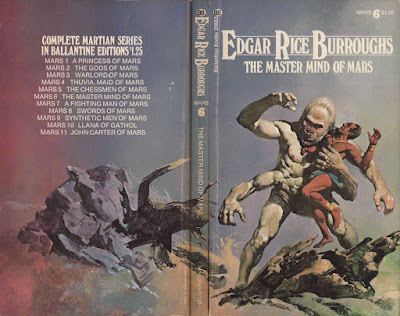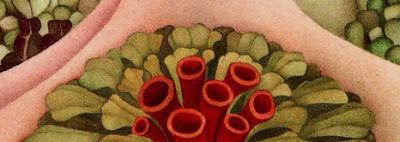 |
| My painting of Taos Pueblo. |
I just spent the better part of a week in the Santa Fe area. I've traveled, camped, and backpacked in New Mexico too many times to count, and Santa Fe is my favorite place to visit. Anyone who reads my blog knows that I delight in finding connections between seemingly far-separated subjects. Thanks to my trip, my brain is a whirl of such connections right now.

One thing that strikes me about Santa Fe is the almost painful juxtaposition of old and new. The region is the setting of Willa Cather's backward-looking
Death Comes for the Archbishop (1927) as well as Aldous Huxley's forward-looking
Brave New World (1931). For both authors, the pueblos represent a link to a world rooted in the past. From the former:
Father Latour lay with his ear to this crack for a long while, despite the cold that came from it. He told himself he was listening to one of the oldest voices of the earth. What he heard was the sound of a great underground river, flowing through a resounding cavern. The water was far, far below, perhaps as deep as the foot of the mountain, a flood moving in utter blackness under ribs of antediluvian rock. It was not a rushing noise, but the sound of a great flood moving with majesty and power.
"It is terrible," he said at last, as he rose.
"Si, Padre." Jacinto began spitting on the clay he had gouged out of the seam, and plastered it up again.
Whenever I'm in the area I pay a visit to
Bandelier National Monument, where the Frijoles Canyon shelters the ruins of the ancient town of
Tyuonyi, the descendants of whose builders dwell at Cochiti Pueblo to the south; perched almost on top of it is the National Laboratory at Los Alamos, where the Manhattan Project was undertaken and where the first atomic bombs were created; beyond that is San Ildefonso Pueblo. Thus are the forces of preservation and destruction violently juxtaposed.
Upon passing the National Laboratory on this trip, I was reminded of a quote from E. F. Schumacher's
A Guide for the Perplexed, which I recently
read:
The pursuit of science is a matter of taking stock and formulating recipes for action. Every recipe is a conditional sentence of the type, "If you want to achieve this or that, take such and such steps." [...] The test of a recipe is purely pragmatic – the proof of the pudding being in the eating. The perfections of this type of science are purely practical – the objective, i.e. independent of the character and interests of the operator, measurable, recordable, repeatable. Such knowledge is "public" in the sense that it can be used even by evil men for nefarious purposes; it gives power to anyone who manages to get hold of it. (Not surprisingly, therefore, many attempts are always being made to keep parts of this "public" knowledge secret!)
Schumacher opposes
knowledge for manipulation (described here) to
knowledge for understanding, without which our civilization is sinking ever deeper into "anguish, despair, and lack of freedom."
 |
The Trinity nuclear test. [source]
"I am become Death, the destroyer of worlds."
[from the Bhagavad Gita, quoted by Robert Oppenheimer] |
My interest in the history and culture of the region has led me to begin collecting pottery from the local pueblos. Each pueblo has its own distinctive style, such as the famous black-on-black technique developed by
Maria Martinez of San Ildefonso Pueblo, which has been exhibited at world's fairs and major museums around the country.
 |
My modest pottery collection. The second and third from the left are from
San Ildefonso, where many of Maria Martinez' kin are still in business.
The others are from Taos, Santa Clara, Acoma, and Santo Domingo. |
I prefer to acquire the pottery by visiting the native artisans and sellers. Entering a pueblo is like stepping into a small foreign country, and you are very conscious of being a guest who might be tolerated but is not particularly welcome. Some, such as Santa Clara Pueblo, are fairly friendly and informal; others are quite strict, and some discourage outsiders altogether. On this trip I was fairly run off from Santo Domingo Pueblo for unknowingly approaching during a day of ceremonial dances, which are closed to outsiders.
 |
Maria Martinez, who developed a new style of blackware, with physicist
Enrico Fermi, who worked on the Manhattan Project and created
the world's first nuclear reactor. [source] |
At Santa Clara, a dealer from whom I ultimately bought a couple of pieces had a long talk with my family, explaining to my children in steps how the pottery was made. At one point he showed us a wedding picture of his grandparents: his grandfather, recently returned from service in World War I, in full uniform, beside his grandmother, looking rather sullen to have her picture taken, in a buckskin dress or robe, and two other men in full costume, with feathered headdresses. A wedding vase sat on the earth at their feet; ruinous adobe brick dwellings loomed behind.
 |
My painting of the adobe church at Los Ranchos de Taos. This church
was painted many times by Georgia O'Keeffe. A thoroughly modern
abstract painter, she found refuge in northern New Mexico after her
years in New York. |
Another site I never fail to visit is the Santuario de Chimayó, a major pilgrimage site and, depending on your outlook, a holy place or an instance of irrational fanaticism (or possibly a curious mixture of the two). The small adobe chapel, built in about 1816, lies at the bottom of a narrow valley on the High Road to Taos, surrounded by rocky red hills and juniper trees.
It resembles many such churches in northern New Mexico, with this exception: a tiny square room, called
el pocito ("the little well"), reached through a door beside the altar, contains a round pit filled with "holy dirt," which can be taken away by the pilgrims and is reputed to perform cures. The long room running from
el pocito alongside the nave holds numerous photos, ex-votos, and discarded crutches.
The town of Chimayó was named for a local hill, known as
Tsi Mayoh in the Tewa tongue. Whether it was a site of devotion for the natives before colonial times is not clear. An old tradition holds that a pueblo formerly stood in the area; a book I have (purchased, of all places, at a tacky tourist gift shop in Clines Corners) describes the experiences of Maria Martinez upon visiting the chapel from nearby San Ildefonso.
 |
| My own picture of the Sanctuario, taken in 2007. |
Most accounts have the chapel built by Don Bernardo Abeyta. An early member of
Los Hermanos de la Fraternidad Piadosa de Nuestro Padre Jesús Nazareno (more commonly known as the
Penitentes, about which more in a moment), Don Abeyta supposedly discovered an ancient crucifix at the pit's location while performing penitential exercises there on Good Friday sometime around 1810.
Signs in the Santuario museum suggest that the crucifix was left there by Spanish explorers. However that may be, Don Abeyta was seemingly devoted to the Christ of Esquipulas, worshiped at a basilica in Guatemala where the clay is also held to have curative properties, a belief possibly adopted from the native culture and "baptized" by the Spaniards. The museum speaks of the ceiba tree, which holds a central place in Maya mythology, hinting (on somewhat slender evidence, it is true) at other connections between Chimayó and the pre-Columbian religions of Central America.
 |
| Esquipulas Basilica, Guatemala, in 1895. [source] |
The Penitentes are credited by some with preserving the Catholic faith in the area during the tumultuous period after the Catholic religious orders were expelled from Mexico. Cather's novel deals with the aftermath of this dark time very effectively. Linked with the medieval Flagellants (in spirit if not in historical continuity), the Penitentes were a secretive sect that the Church sought to suppress after the capture of the Southwest by the United States and the division of the current archdiocese from that of Durango.
An interesting book I have,
Missions and Pueblos of the Old Southwest (1929), written by one
Earle R. Forrest, who had once worked as a cowboy in the Arizona desert and had traveled throughout the area extensively before the arrival of the first automobiles, devotes a chapter to the Penitentes. According to him, the brothers would scourge themselves with chunks of cholla cactus woven into thongs of rope; crucifixion ceremonies were held in remote places at night, and sometimes the
Cristo whose ardor was thus tested never returned.
The book is illustrated with photographs taken by the author; one depicts a Penitente
morada, or meeting house, and another purports to be the only known photograph of a Penitente procession:
The piety of the Penitentes plays a role in
Brave New World. The protagonist, John, raised on a Savage Reservation in New Mexico, becomes a sign of contradiction in the World State, and creates a public spectacle in his attempts at purification through self-flagellation:
"But I don't want comfort. I want God, I want poetry, I want real danger, I want freedom, I want goodness. I want sin."









































